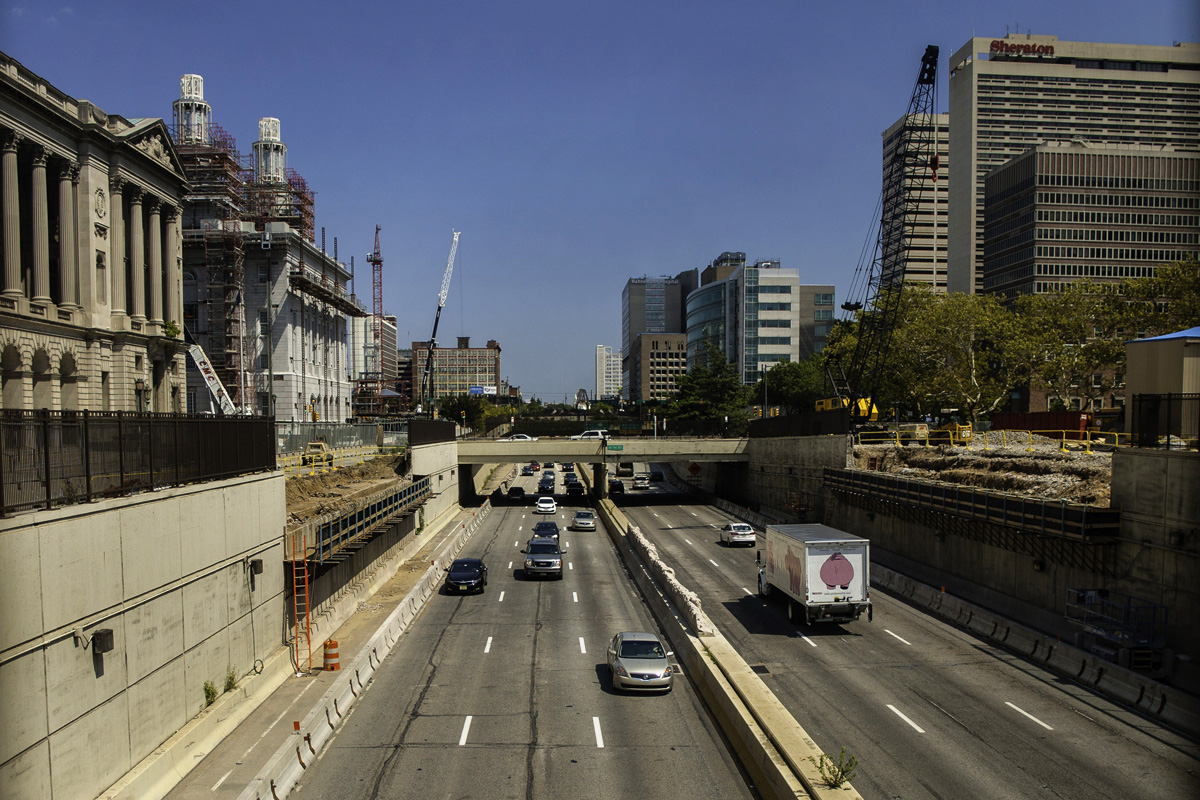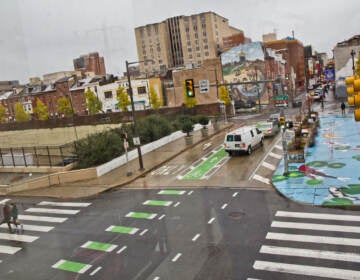U.S. DOT to cities: New highway projects can mend old scars

In an interview last week with PlanPhilly, U. S. Secretary of Transportation Anthony Foxx outlined his efforts to encourage policymakers to rethink how cities deal with inner city highways through the Department of Transportation’s new Every Place Counts Design Challenge.
Officials with Philadelphia’s Office of Transportation and Infrastructure Systems (OTIS) submitted an application to the Secretary’s challenge, which was announced last month and will offer four winning cities free two-day planning charrettes run by DOT planners. The charrettes will focus on how to minimize the deleterious impact of urban highways on the communities they dissect and wall off.
Philadelphia is home to at least four prime candidates for the challenge, which required applicants to identify highways dividing urban communities that have either ongoing or upcoming construction: I-95, I-676, I-76 and US-1 all create rifts in Philadelphia’s neighborhood fabric.
The goal of the challenge is to “reimagine existing transportation projects via innovative and restorative infrastructure designs that reflect a more inclusive America, reconnects people and neighborhoods to opportunity, and reinvigorates opportunities within communities by empowering and encouraging communities and decision-makers to work together to develop context-sensitive designs that reflect and incorporate the input of the people and communities they touch.”
Philadelphia’s application focuses on the Vine Street Expressway east of Broad Street, focusing on how to better connect some of the parts of Chinatown that still remain north of the highway with the larger, bustling community to the south. With the Rail Park proposal expected to break ground sometime in the near future, new development, and placemaking initiatives like the Pearl Street Connector, now’s the time to bridge that highway’s divide, said OTIS officials.
There 56 design challenge submissions as of last week, according to Foxx.
Foxx described the program as an effort at the federal level to change how city planners and transportation engineers approach highway design. “We’re trying… to inject the idea that we are not just creating throughput when we put transportation facilities in place,” said Foxx. “We’re actually creating place.”
When asked specifically what he might want to see in Philadelphia, Foxx described processes and mindsets rather than specific proposals. “There are projects that are either on the books or are on the process of being done that would ameliorate some of the damage that was done in the earlier eras,” said Foxx.
Foxx said more power should be given to local communities to set transportation policies like highway design, which falls largely to state agencies. “I’d like to see more resources dedicated to [Metropolitan Planning Organizations] and to the local communities to be able to define the future for themselves,” said Foxx, who said MPOs like the Delaware Valley Regional Planning Commission needed to have a greater say in highway design, including the rebuilding of many stretches of interstate that are now reaching the end of their useful life.
Currently, I-95 is in the midst of a multi-year rebuild throughout most of its run through Philadelphia, causing some to advocate for more intensive interventions to reduce the highway’s footprint on the city, by either capping it with a cover where it’s sunken below grade, improving underpass access where it’s elevated, or even diverting it completely. Plans to cap I-95 between Chestnut and Walnut Streets are being studied now. More ambitious proposals to bury most of the highway seem to have been abandoned.
Foxx emphasized the need for everyday residents to join the planning efforts, stressing the need for planners to reach out to those communities. “I think the most important thing is for people to realize they do have a voice, even if the process is imperfect if they have a voice they can impact the outcome,” said Foxx.
Community voices, in the form of online petitions, came too late in the design process to broaden the scope of some overpass rehabilitation work on I-676. When construction bids came in at $55 million—$42 million below the original $98 million estimate—the project was unable to expand to use those savings to cover more of the below-grade highway because the necessary design work had never been done.
The Every Place Counts Design Challenge will provide technical assistance on planning projects, not engineering or design work. Even if Philadelphia wins, it’s not clear that it’ll change much here. City and DVRPC officials insist they are thinking about these challenges already. It isn’t technical assistance they need: It’s funding. Even post Act 89, which increased transportation infrastructure budgets across the Commonwealth in 2013 through increased gas taxes, planners need to fight for every dollar. When I-676 came in under budget, PennDOT shifted the $42 million windfall towards reconstruction of Chestnut Street’s bridge over the Schuylkill River.
WHYY is your source for fact-based, in-depth journalism and information. As a nonprofit organization, we rely on financial support from readers like you. Please give today.




